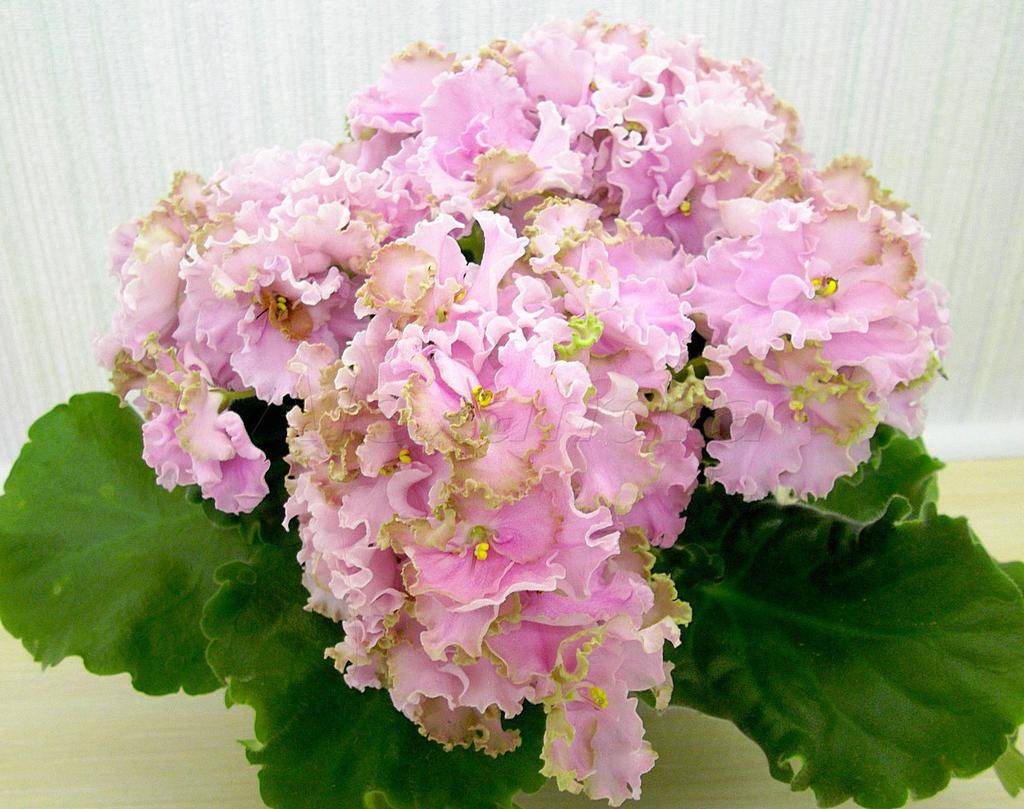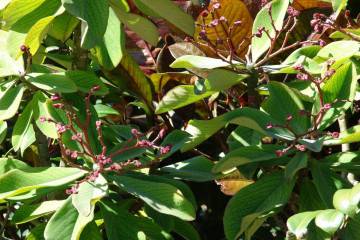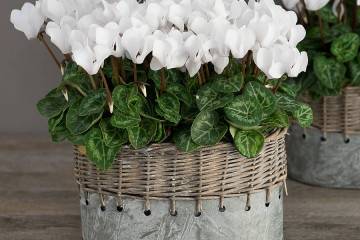Violet gold of the Scythians - description of the variety of home flowers
Content:
- What does the violet Zlato Scythians look like, which family does it belong to?
- Features of caring for a violet Zlato Scythians at home
- When and how it blooms
- How to propagate a violet Zlato Scythians at home
- Repotting after purchase and when growing from seed
- Possible problems in growing violets Gold of the Scythians
This indoor flower is called saintpaulia. However, most people like to call it the more familiar word violet, thereby confirming that the plant belongs to the family of the same name.
What does the violet Zlato Scythians look like, which family does it belong to?
The plant has large double flowers of a white-yellow hue. The ruffled petals are decorated with a pale pink border.
If you observe the plant in cool conditions, you will notice the formation of a light green fringe at the edges of the petals. When budding, the petals of the flower are always light with a monochromatic color. Saturation with a bright color occurs in 2-4 days during the period of full growth and development of the plant.
The violet plant Gold of the Scythians is the result of selection work. There are many varieties with a similar name. Known varieties are LE-Gold of the Scythians, as well as AV-Gold of the Scythians. These varieties are similar to each other. The difference is that the former has a brighter pink tint.
Violet Le Zlato Scythians is a variety bred by Ukrainian breeder Elena Lebetskaya in 2015. As a result of her work, 250 varieties of violets have appeared, which have a reference to authorship in the name, which is reflected in the prefix "Le".
Features of caring for a violet Zlato Scythians at home
The flower grows well under certain conditions of care. It is possible to achieve a lush look, a rich shade, including at leafy rosettes, if we take into account all the important factors affecting healthy growth.
Temperature
Violet Gold Scythians do not like cold. Such flowers should be grown at a normal room temperature of 22 degrees. Drafts, a change in temperature regime will have a negative effect on the flower, up to a complete cessation of growth.
Lighting
Violet flowers Zlata are fragile and delicate. They need a lot of light. The room where they will be located must be well lit. At the same time, the flowers must be protected from direct sunlight. If these rules are not followed, the plant will not be able to develop normally. Violets are best placed under soft, diffused light. For them, this lighting is the most optimal.
Watering
It should be held periodically, depending on the season. In summer, in hot weather, watering the color is required more often. On average, violets are watered once a week to prevent the soil from drying out.
Violets thrive in high humidity. A container of water is often placed next to the pot or special devices are used to humidify the room.
Priming
The land for the violets is prepared at home on their own. Sifted garden soil is mixed with sand. The resulting mass is calcined in the oven to neutralize various parasites and pathogens.
At the bottom of the tank, where the soil is laid, drainage from expanded clay is preliminarily arranged.
Top dressing
Top dressing is an important factor in plant health. Violets need phosphorus, potassium, nitrogen-containing compounds. Fertilizers are applied to the soil when the plant is intensively growing and developing. This usually happens during the summer season. In winter and autumn, the soil "rests" and is not fed.
When and how it blooms
Violets primarily attract with their lush flowering, delicate shade, shape of leaves and flowers.
The most famous varieties have similar shapes and different colors in the inflorescences. The cultivar LE-Zlato Scythians, bred in 2015, given as an example, is the owner of large double flowers of a white-yellow shade with corrugated petals, "outlined" with a pale pink border. Unlike the given variety, the AV-Gold of the Scythians violet, bred a year earlier, has a different color. A flower with white-yellow simple, semi-double petals-stars, which have bright pink edges. The rosette is represented by leaves of medium size, saturated green tone with a wavy toothed shape.
Flowering occurs in the summer with the capture of early autumn. A feature can be called the appearance of the first buds at the time of leaf development.
How to propagate a violet Zlato Scythians at home
Saintpaulia reproduces by seed. This method is preferred by breeders.
Most often, when breeding violets, the seed germination method is ignored. The best option is considered to be propagation by leaf cuttings. The cut leaf is placed in a glass of water and the roots are waited for.
The transplant of young leaves is carried out with the utmost care, given their increased fragility. Flowering plants or those in the budding stage are taken. Placing cuttings in the ground should be carried out at an angle of 45 degrees.
To count on good reproduction, you should use the central part of the outlet to select a leaf. Here are not too young and at the same time completely healthy leaves. At the place of the sheet cut, treatment with a solution of potassium permanganate is carried out or, as a replacement, powdered coal is used.
After planting, the planting material is placed in a separate container, into which warm clean water is poured. This is necessary for rooting.
An additional way is transplanting with peduncles.
Repotting after purchase and when growing from seed
Having bought an adult plant or seeds, they are immediately freed from the soil in which they were in the store and transplanted into a good prepared soil. As is often the case, store land is of poor quality and needs to be replaced.
Small containers are prepared for seed transplantation (like 50 ml plastic cups in which baby curd is sold). Holes are made at the bottom of the container. Drainage is done. Pour expanded clay, sprinkle it with sand. Be sure to add charcoal in the same proportion as the sand. Next, backfill with earth is made. The seeds are placed in moist soil.
Containers with planted seeds are kept in a warm room. The first shoots appear after three weeks.
Possible problems in growing violets Gold of the Scythians
The main problems faced by flower growers arise from improper care.
Improper care can affect the leaves of the flower. Dark spots may form on them. This is the result of non-compliance with watering rules, excessive waterlogging of the soil. In addition, spots appear if you spray and leave the plant in a draft.
In the heat, violets can pick up bacteriosis.The disease can be identified by the darkening of the trunk and cuttings, which, if not taken care of, completely rot. You should monitor the flowers, do the re-rooting of diseased outlets, arrange a light soil.
Of the pests, violets are more often threatened by spider mites. If high humidity exists, mealybugs may develop. For destruction, special preparations can be purchased in stores.
Proper care of violets Gold of the Scythians or Gold of the Scythians always becomes the key to their lush and bright flowering. Many flower growers want to keep such flowers at home. They create an atmosphere of harmony, comfort, peace in the house.




















